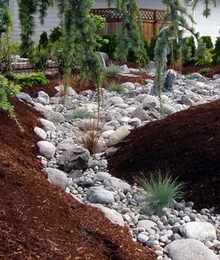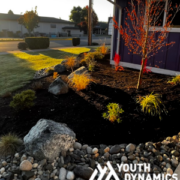Drainage Solution | Dry River Beds

The Concept of Dry River Beds
Winter brings precipitation in droves, and that calls for a drainage solution that will foster effective water management. One such solution gaining popularity is the use of dry river beds as a sustainable drainage system. Integrating nature-inspired solutions like dry river beds not only addresses pressing issues such as stormwater management but also encourages a deeper connection to the natural world.
Dry river beds, also known as swales or bioswales, mimic the natural course of a river but remain dry under normal conditions. They are designed to manage stormwater runoff, reduce flooding, and enhance groundwater recharge. Proper design considers the slope and topography of the area to ensure effective water flow and dispersion. Strategic placement of the dry river bed within the landscape is crucial for optimal functionality. By replicating the characteristics of natural river systems, these dry beds allow for effective water dispersion and absorption. These types of landscape designs are a harmonious and synergistic drainage solution. (Washington, it rains here! Who knew?)


Benefits of Dry River Beds
Functionality:
The primary purpose of a dry river bed is to slow down, filter, and redirect stormwater runoff. The design incorporates rocks, gravel, and vegetation to create a path for water to flow. As water moves through the system, pollutants are filtered out, and the excess water is gradually released into the ground. This helps prevent soil erosion, recharge groundwater, and reduce the burden on conventional stormwater drainage systems.
Stormwater Management:
Dry river beds excel in managing stormwater by slowing down its flow and allowing for infiltration. This helps prevent flooding in urban areas, especially during heavy rainfall, by reducing the volume and velocity of runoff.
Pollution Reduction:
As stormwater passes through the dry river bed, natural filtration occurs. Rocks, gravel, and vegetation trap pollutants, sediments, and debris, preventing them from reaching water bodies. This natural cleansing process contributes to improved water quality.



Proudly serving Skagit, Whatcom, Island, and north Snohomish counties since 2001.










